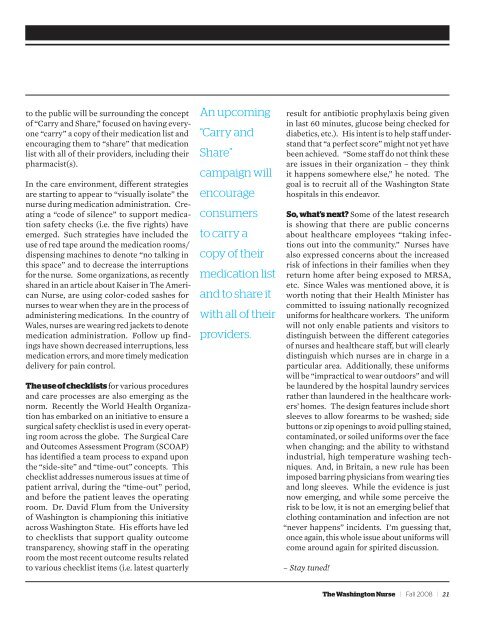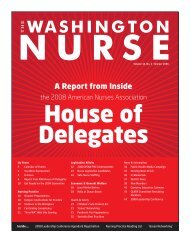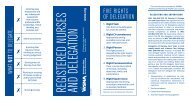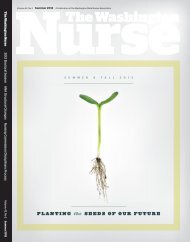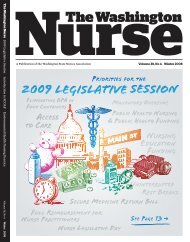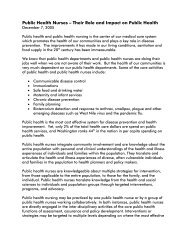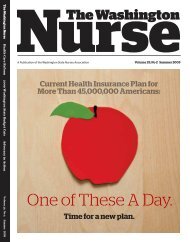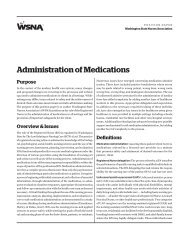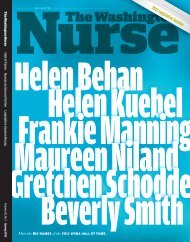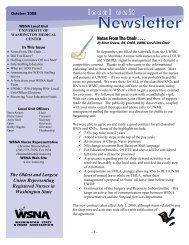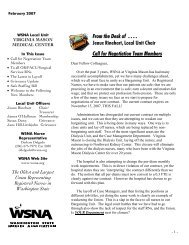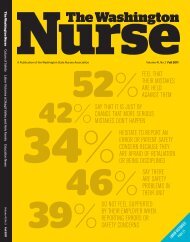Issue 38.3 - Fall 2008 - The Washington State Nurses Association
Issue 38.3 - Fall 2008 - The Washington State Nurses Association
Issue 38.3 - Fall 2008 - The Washington State Nurses Association
Create successful ePaper yourself
Turn your PDF publications into a flip-book with our unique Google optimized e-Paper software.
to the public will be surrounding the concept<br />
of “Carry and Share,” focused on having everyone<br />
“carry” a copy of their medication list and<br />
encouraging them to “share” that medication<br />
list with all of their providers, including their<br />
pharmacist(s).<br />
In the care environment, different strategies<br />
are starting to appear to “visually isolate” the<br />
nurse during medication administration. Creating<br />
a “code of silence” to support medication<br />
safety checks (i.e. the five rights) have<br />
emerged. Such strategies have included the<br />
use of red tape around the medication rooms/<br />
dispensing machines to denote “no talking in<br />
this space” and to decrease the interruptions<br />
for the nurse. Some organizations, as recently<br />
shared in an article about Kaiser in <strong>The</strong> American<br />
Nurse, are using color-coded sashes for<br />
nurses to wear when they are in the process of<br />
administering medications. In the country of<br />
Wales, nurses are wearing red jackets to denote<br />
medication administration. Follow up findings<br />
have shown decreased interruptions, less<br />
medication errors, and more timely medication<br />
delivery for pain control.<br />
<strong>The</strong> use of checklists for various procedures<br />
and care processes are also emerging as the<br />
norm. Recently the World Health Organization<br />
has embarked on an initiative to ensure a<br />
surgical safety checklist is used in every operating<br />
room across the globe. <strong>The</strong> Surgical Care<br />
and Outcomes Assessment Program (SCOAP)<br />
has identified a team process to expand upon<br />
the “side-site” and “time-out” concepts. This<br />
checklist addresses numerous issues at time of<br />
patient arrival, during the “time-out” period,<br />
and before the patient leaves the operating<br />
room. Dr. David Flum from the University<br />
of <strong>Washington</strong> is championing this initiative<br />
across <strong>Washington</strong> <strong>State</strong>. His efforts have led<br />
to checklists that support quality outcome<br />
transparency, showing staff in the operating<br />
room the most recent outcome results related<br />
to various checklist items (i.e. latest quarterly<br />
An upcoming<br />
“Carry and<br />
Share”<br />
campaign will<br />
encourage<br />
consumers<br />
to carry a<br />
copy of their<br />
medication list<br />
and to share it<br />
with all of their<br />
providers.<br />
result for antibiotic prophylaxis being given<br />
in last 60 minutes, glucose being checked for<br />
diabetics, etc.). His intent is to help staff understand<br />
that “a perfect score” might not yet have<br />
been achieved. “Some staff do not think these<br />
are issues in their organization – they think<br />
it happens somewhere else,” he noted. <strong>The</strong><br />
goal is to recruit all of the <strong>Washington</strong> <strong>State</strong><br />
hospitals in this endeavor.<br />
So, what’s next Some of the latest research<br />
is showing that there are public concerns<br />
about healthcare employees “taking infections<br />
out into the community.” <strong>Nurses</strong> have<br />
also expressed concerns about the increased<br />
risk of infections in their families when they<br />
return home after being exposed to MRSA,<br />
etc. Since Wales was mentioned above, it is<br />
worth noting that their Health Minister has<br />
committed to issuing nationally recognized<br />
uniforms for healthcare workers. <strong>The</strong> uniform<br />
will not only enable patients and visitors to<br />
distinguish between the different categories<br />
of nurses and healthcare staff, but will clearly<br />
distinguish which nurses are in charge in a<br />
particular area. Additionally, these uniforms<br />
will be “impractical to wear outdoors” and will<br />
be laundered by the hospital laundry services<br />
rather than laundered in the healthcare workers’<br />
homes. <strong>The</strong> design features include short<br />
sleeves to allow forearms to be washed; side<br />
buttons or zip openings to avoid pulling stained,<br />
contaminated, or soiled uniforms over the face<br />
when changing; and the ability to withstand<br />
industrial, high temperature washing techniques.<br />
And, in Britain, a new rule has been<br />
imposed barring physicians from wearing ties<br />
and long sleeves. While the evidence is just<br />
now emerging, and while some perceive the<br />
risk to be low, it is not an emerging belief that<br />
clothing contamination and infection are not<br />
“never happens” incidents. I’m guessing that,<br />
once again, this whole issue about uniforms will<br />
come around again for spirited discussion.<br />
– Stay tuned!<br />
<strong>The</strong> <strong>Washington</strong> Nurse | <strong>Fall</strong> <strong>2008</strong> | 21


